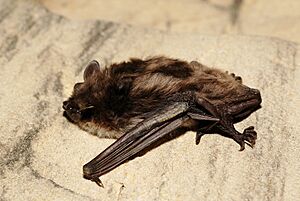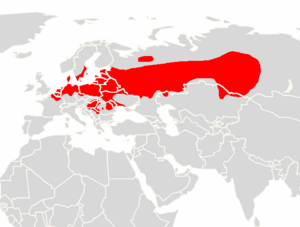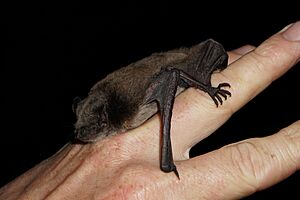Pond bat facts for kids
Quick facts for kids Pond bat |
|
|---|---|
 |
|
| Conservation status | |
| Scientific classification | |
| Genus: |
Myotis
|
| Species: |
dasycneme
|
 |
|
The pond bat (Myotis dasycneme) is a type of vesper bat. These bats live near water. You can find them across a large area called Eurasia. This stretches from France all the way to Russia and Kazakhstan.
Contents
What Does a Pond Bat Look Like?
Pond bats are medium-sized. They have a small ear flap called a tragus. Their fur is thick. It is dark brown or black near the skin. On their back, the fur is brownish or yellowish-grey. Their belly fur is white-grey or yellow-grey.
Pond Bat Status: Are They in Danger?
Sadly, pond bats are facing some challenges. In some parts of their home, like the Netherlands, their numbers have dropped a lot. This is because many places where they raise their young have been lost.
Globally, they are considered "near threatened." This means they could become endangered soon if we don't protect them. Scientists need more information from the eastern parts of their range to fully understand their situation.
Where Do Pond Bats Live?
Pond bats like to live in lowland areas during the summer. These areas usually have water, open meadows, and woods. In winter, they often move to roosts in the foothills of mountains.
The highest a pond bat has been found living is about 1,000 meters (3,280 feet) above sea level. However, their winter homes are usually not higher than 300 meters (984 feet). In summer, they often roost in roof spaces or church towers. Sometimes, they even live inside hollow trees.
Pond Bat Life Cycle and Reproduction
Female pond bats are ready to have babies when they are two years old. The mating season starts around the end of August. The following May, female bats gather in special "nursery roosts." These roosts can have anywhere from 40 to 400 females. Males rarely join these nursery groups.
Most summer nursery roosts are in human buildings. They often choose places like attics and church steeples. Sometimes, pond bats also roost in trees or special nest boxes. The oldest recorded pond bat lived to be 19 years old!
How Pond Bats Hunt for Food
Pond bats are excellent hunters. They hunt over calm or still water. This includes places like canals, rivers, and lakes. They mostly eat insects that come out of the water. Often, they catch their prey right from the water's surface.
How Pond Bats Use Echolocation
Pond bats use a special skill called echolocation to find their way and hunt. They send out high-pitched sounds. These sounds are called FM signals. They range from 60 to 24 kilohertz. Each sound lasts for about 5 to 8 milliseconds.
They send out about 8 to 10 signals every second. This happens about every 115 milliseconds. These sound signals can travel between 5 and 21 meters (16 to 69 feet). This helps them "see" their surroundings in the dark.



